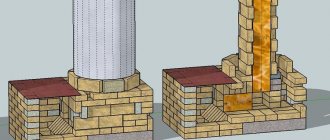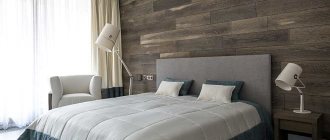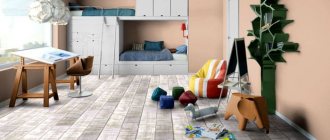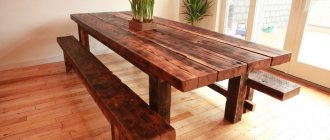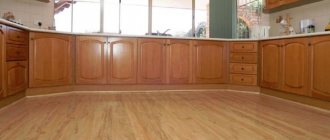If you think that linoleum in the kitchen is temporary and frivolous, then get ready for a serious alteration of your picture of the world. This material has long since firmly moved from the category of budget flooring options to a much more presentable segment and sometimes completely outshines ceramic tiles and laminate in terms of expressiveness—and practicality at the same time. But in order to successfully choose linoleum for the kitchen, you first need to thoroughly understand its types and characteristics: here and now we are conducting a narrowly focused educational program with a large number of photos of real interiors for clarity.
Advantages and disadvantages
«+»:
- soft and elastic coating that is difficult to damage by a dropped plate or any other object;
- does not attract dust and is very easy to clean, while the likelihood of fungal structures or mold appearing is close to minimal;
- has excellent thermal insulation and does not cool, creating comfort at any time of the year, even in frosty winter;
- remains virtually silent under any influence on it;
- low price even for the best options;
- excellent wear resistance - up to 15 years;
- “friendly” with abrasive detergents.
«-«:
- softness leads to pressing in places where heavy furniture stood, which seriously limits your manipulations during rearrangement;
- the seams are clearly visible, indicating the junction of one fragment with another - this spoils the appearance a little;
- even the most reliable type of linoleum can lose its color over time;
- in some cases, an unpleasant odor is observed, which goes away over time;
- It is easy to cut and scratch, so it is inferior in reliability to alternative options (the same tile or laminate).
For example, this is what happens to linoleum if you move furniture too carelessly (in this case, a refrigerator).
What are the main points you should pay attention to when choosing linoleum for the kitchen?
Linoleum is an environmentally friendly flooring made from natural materials. This wear-resistant coating has a very long service life. Linoleum is resilient and has antibacterial properties, making it a particularly good choice for kitchens.
Four selection criteria will help you learn better about the features of linoleum
Material. Linoleum is made from natural materials including linseed oil, resin, wood flour and pigments.
Since these materials are of natural origin, they are also biodegradable, which is considered a definite advantage when choosing an environmentally friendly coating.
In addition, flaxseed oil is a powerful antiseptic. Thanks to this property, linoleum will protect the floor from harmful bacteria throughout its entire service.
Thickness. The kitchen floor has a purpose rather than a decorative purpose. The appropriate kitchen covering must withstand heavy loads without deforming, remain wear-resistant, and maintain an impeccable appearance.
The thickness of linoleum determines its wear resistance. Especially for kitchens there is linoleum with a thickness of 4-5 mm. This high-performance coating will withstand any intense load.
Coating. Unlike vinyl flooring, the pigments in linoleum run throughout the entire thickness of the material. Any scratches or heavy wear will be the same color as the surface, minimizing visual impact.
Slip. An important feature of linoleum is that, due to its coating, it usually has a rough surface. Therefore, linoleum is popular in places with high humidity.
The fact that this flooring is so easy to clean adds a lot of benefits, but the benefits don't end there.
Types of linoleum
It is easy for anyone to get confused in the classification of material. Let's try to understand all types of linoleum in order to choose the best option for the kitchen.
By material
If we take as a basis the characteristics of basic materials, we can highlight:
- natural - lime or cork conglomerate is applied to jute or flax fiber;
- artificial - made of PVC or rubber.
The first option is very expensive, but environmentally friendly and is recommended for finishing floors in children's rooms. But linoleum made from artificial materials is widespread because it gives the best quality for the price.
By the number of layers in the canvas
- homogeneous - single-layer, completely homogeneous in structure, most often used in public spaces with high traffic;
- heterogeneous - a two-layer or multi-layer structure, widely used for finishing floors in modern apartments and houses.
By purpose
But here the thickness of the layer plays a role - this directly affects the service life and abrasion class:
- commercial - has a single-layer structure 0.7 cm thick, made of PVC, intended for use in public buildings, service life - up to 45 years;
- semi-commercial - felt is added to the composition, which significantly improves the thermal insulation qualities of the material, thickness - 0.5 cm, service life - up to 12 years;
- household - on a foamed felt base, the most versatile and aesthetically pleasing type, recommended for use at home.
Household linoleum: structure and main characteristics
Household-grade linoleum is a floor covering made of a polymer material that is used in residential areas where the load on the floor is moderate. This is a heterogeneous coating that has several layers:
- the lower one, on which the strength of the linoleum and the evenness of the installation depend;
Household linoleum is much cheaper than commercial linoleum and has sufficient wear resistance for use in living rooms for any purpose.
- a foam base that provides thermal insulation and sound absorption, it makes the coating elastic;
- a layer of fiberglass and PVC helps maintain linear dimensions;
- the face ball is a base with a printed pattern;
- A protective clear coating provides additional protection against abrasion.
Helpful advice! It is quite possible to buy cheap household grade linoleum, but the choice of its decor and colors will be less varied. The manufacturer offers regular promotions and discounts on certain models. To choose the right option, it is best to use the Tarkett linoleum catalog. Photos, prices and characteristics under each model will help you make your choice.
The structure of household linoleum
This coating is considered the most popular on the domestic market, as it is a natural material made on a foam base. It is versatile, practical and durable. Photos of linoleum colors indicate its diversity. In addition, it is not difficult to install and care for is quite simple. Experts consider Tarkett household-grade linoleum safe for people.
Related article:
How to lay linoleum: rules for cutting and laying flooring
Rules for cutting material. How to choose a suitable adhesive composition. Basic principles of coating care.
Household linoleum Tarkett: catalog, photo collections
In the Tarkett catalog, household-grade linoleum is presented in a number of collections that are most in demand by customers. The maximum strength and aesthetic characteristics of natural materials are embodied in the Discovery series. “Favorite” is a variety of flooring for living rooms, successfully imitating palace parquet, wood or tiles, and the “Magic” collection is a wide range of models for the kitchen.
Taking into account consumer demands, the company has prepared a Grand collection, which has already been tested by demanding customers. Grand household linoleum has a record thickness of 4.5 mm - this is its main feature.
Tarkett household linoleum enjoys well-deserved popularity among Russian consumers
Among the new products, several collections of household linoleum deserve special attention:
- The Caprice assortment meets the most sophisticated requirements of demanding consumers in 13 trendy designs. Special technologies are used in the production of the coating. Photos of the interior of Tarkett linoleum from this series demonstrate that it fits well into any room.
- “Europe” is one of the most popular collections, as it represents the ideal ratio of price and quality in Tarkett linoleum.
- Premium is the newest series, which consists of luxurious flooring models. This is an ideal option for lovers of high cost and sophistication in the interior.
- Discovery is a collection for those who love nature. Includes a variety of flooring options for parquet or solid wood without harming the environment.
Which linoleum is best for the kitchen?
Of course, there are no ideal options: in each individual case something has to be sacrificed. In order to choose linoleum for the kitchen, it is not enough to just look at photos of options on the Internet and make a purchase - you must study all the characteristics of the material, note the presence or absence of harmful chemical additives in it, and inquire about the declared service life.
Your gaze lingered on some solution with a photo - read the reviews of those who have already laid such linoleum in their kitchen. It is quite possible that in people’s messages you will find answers to questions that have already arisen in your head.
Nevertheless, we can draw a very specific conclusion: if the specification exists, it means that someone needs it. This means that the heterogeneous flooring material with the following indicators, declared for installation in residential buildings and apartments, is suitable for the kitchen:
- environmentally friendly;
- moisture resistant;
- fire resistant;
- moderately embossed.
Features of linoleum
Before choosing the best linoleum, you should familiarize yourself with its characteristics. The main advantages of the material are resistance to different levels of humidity and mechanical damage, strength, large color palette, elasticity and ease during installation work.
In order to finish the floor you do not need to have special skills or knowledge. If there are instructions, anyone can lay linoleum.
How to choose linoleum
To do this correctly, you need to take into account the specifics of the kitchen as a strictly functional room. Therefore, linoleum should not only meet your aesthetic needs, but also be:
- resistant to mechanical stress - falling spoons, knives, forks, plates, etc. should not damage its surface layer;
- moisture-resistant - even under the influence of water regularly falling on it, it should not swell and rot;
- not slippery - there are plenty of sharp objects in the kitchen, so any fall is fraught with serious injury, but beware of overly textured textures, as dirt easily gets clogged into the pores, and maintenance will be extremely difficult;
- immune to abrasive detergents - of course, under the influence of steam, smoke, soot it will become dirty, but the wider the list of products allowed for cleaning, the easier it will be to care for the floor covering;
In addition, it should not contain colloxylin, a flammable material. This is unacceptable for the kitchen.
When directly choosing linoleum in a store, be sure to take an interest in its labeling - from it you can easily determine the resistance class and purpose of the material, no matter what the consultant in the store says while offering this or that option. Let's share this important information so you don't get into trouble:
- 21-23 - for installation in residential buildings and apartments;
- 31-33 - for installation in offices;
- 41-43 - industrial enterprises only.
The abrasion class is also important:
- F - this coating deteriorates very quickly;
- M and P - average abrasion, suitable for use in domestic conditions, including in the kitchen;
- T is a practically indestructible material; as a rule, this mark is typical exclusively for commercial linoleum made from PVC.
From all this we can conclude that the most reliable linoleum is commercial, homogeneous. So why not use it in everyday life?
We answer: for use at home, especially in the kitchen, you need to select the cleanest and safest material possible that will not affect human health and release harmful substances into the air under the influence of high temperatures and permanent humidity.
Therefore, there is no need to be cunning and, in pursuit of service life, jeopardize your own comfort and the well-being of your household. Residential offers impressive decorative potential, while semi-commercial offers exceptional reliability. It is these 2 types that are most often found in modern interiors.
Tarkett semi-commercial linoleum: characteristics and features
Manufacturers have implemented a balance of the basic properties of household and commercial classes in semi-commercial linoleum. The price corresponds to the ideal combination of the most sought-after positive qualities. Coatings of this class are characterized by higher strength, wear resistance and durability than household linoleum. Therefore, in rooms of residential buildings with increased load, for example, in kitchens and hallways, it is advisable to use such material.
Important! Unlike commercial, semi-commercial linoleum is represented by a wider range of different design solutions, which significantly expands the scope of application of such a coating.
In the Tarkett catalog, semi-commercial linoleum is presented in a wide range of models in several series.
- The Force series, which means “strength”, lives up to its name and is characterized by increased wear resistance. The models correspond to the standard design style.
- The Sprint collection consists of flooring materials that imitate parquet and wood flooring.
- The Fashion series successfully conveys the texture of natural stone.
- Idylle is a collection divided into two separate directions (Nova and Tango), imitating natural wood.
Thanks to the protective film, the design does not lose its freshness, and the coating itself wears out more slowly
An abundance of all kinds of colors, sizes and textures, the ability to choose linoleum of any design style - all this is offered by the Tarkett catalog of semi-commercial linoleum. Photos give a visual impression and make it easier to choose the right model.
How much does a meter of linoleum cost: components of the price of the material
Modern linoleum is distinguished by a variety of textures and shades. What distinguishes it from other floor coverings is its price, which is much lower and more attractive. Actually, the cost of linoleum coating is influenced by several factors, in particular:
- square footage of the room and the amount of material required;
- condition of the floor surface;
The price of linoleum largely depends on which group this coating belongs to.
- coating class;
- country of origin and brand.
You can calculate the required amount of material by measuring the length and width of the room. To calculate the area, the length is multiplied by the width. Door and window openings add +10 cm each to the total area; connecting elements should also be taken into account.
Next, select the width of the roll. It should be such as to avoid the presence of joints or reduce their number as much as possible. By drawing up a room diagram, you can get a clear picture of the entire area and the total amount of material consumption. The drawing should show projections, openings and other features.
Depending on which company produced the material, the cost of linoleum may vary
To prepare the surface, you need to carry out special work: make a screed or prepare a special substrate. The direct price of the material itself is determined by the type of flooring and its brand.
Which linoleum to buy: the price of coatings depending on the classification
Household linoleum is one of the most affordable (in terms of price) floor coverings. Minimum cost of linoleum per 1 sq. a meter starts from 170 rubles.
Semi-commercial linoleum is very popular due to its combined properties, which harmoniously combine strength and decorativeness. Accordingly, the price of such coverage is much more expensive. In catalogs, the price of semi-commercial linoleum starts from 300 rubles per square meter.
Household linoleum is the cheapest and most diverse in terms of design
Commercial grade coating is impregnated with a special compound in several layers. This makes it as durable, protected, safe as possible, and therefore suitable for a variety of premises. These qualities regulate the price, which can exceed 1,500 rubles. Installing such a coating is not an easy process; it is better to entrust the installation of expensive material to professionals.
According to the Tarkett catalog, linoleum of this brand has practically no drawbacks, with the exception of prices that are slightly above average. This is justified by the high quality of the products, which has been confirmed by millions of consumers.
The direct cost of the coating depends on its thickness - the thicker the material, the higher its price
Helpful advice! When purchasing linoleum, you should keep in mind that a low price often indicates a low quality material. This coating will not last long. It may happen that it will have to be replaced soon.
Linoleum under tiles
Why bother with the painful installation of ceramic tiles on the floor when you can simply choose an excellent synthetic material with a similar texture?
It is enough to look at a few photos of linoleum under the tiles to want this material for your kitchen - manufacturers offer a very skillful imitation with good performance qualities.
Not only the texture itself is imitated, but even the seams. It turns out very convincing, and the simulated seams do not wear out over time. This linoleum in the kitchen interior looks like real tiles. Judge for yourself from the photo.
Durability of linoleum
Durability is an important factor. Easily damaged linoleum will look bad in the kitchen. Running pets, children, adults :-), falling appliances and everything else can damage it, and since linoleum is a solid material, you will have to either change the entire covering or adjust a piece to match the design.
Durable material must also withstand heavy household appliances and household items that are constantly in the kitchen and in the house as a whole.
Linoleum under laminate
Imitating the structure of wood on the floor helps create a carefully balanced balance in the room. The interior becomes calm and homely, which is very important for a feeling of comfort.
Of course, in this segment the options are simply endless. However, due to the fairly high demand for the Scandinavian style, bleached oak options are especially popular.
If you want to make the interior warmer, Canadian pine or linoleum under the parquet board will help out. In the latter case, be sure to take into account the direction of the stripes in order to successfully integrate such a solution and take into account the peculiarities of the kitchen layout.
The photo shows “Ideal Ultra” laminate in Colombian oak color in the interior of a light kitchen of 10 square meters.
And this is Tarkett Discovery Hudson linoleum. The ideal color temperature for the floor!
The stylized wood “Forrest” looks very convincing, which can be found in the Leroy Merlin network of hardware stores.
Types of linoleum
This finishing material has many types. The properties of linoleum largely depend on what material it is made from.
Natural
This type of flooring is suitable for allergy sufferers and those who fundamentally use only eco-friendly materials. It is made from wood and limestone flour with the addition of resins, natural dyes and linseed oil. Jute fabric is used for the substrate, the top layer is sometimes coated with varnish or polymer, and often you can find linoleum without any coating at all.
The finishing material has all the advantages: it is beautiful, easy to install, is not afraid of water and temperature changes, and also does not accumulate static electricity and cannot cause allergies.
It has only one drawback: it is not as elastic as other varieties, so it must be transported not in rolls, but in sheets. Otherwise, unsightly folds form on the surface, which then spoil the entire unusual design of the room.
PVC linoleum (polyvinyl chloride material)
PVC flooring is the most common option. It is made from polyvinyl chloride. There are several varieties:
- single layer. It is not durable, but it is bright and cheap. It is quite suitable as a temporary solution before an upcoming major overhaul;
- two-layer. It is used more often because it lasts longer and is generally stronger. Here the polyvinyl chloride layer is thicker.
All synthetic linoleum has a weak, specific odor that takes a little time to dissipate. You may be allergic to it. Otherwise, this is a good material: it comes in different colors, matte and glossy, it can be combined with other coatings, and used to cover an office or hall. It is this linoleum that accurately imitates other surfaces.
Relin, or rubber linoleum
It is made from crushed rubber and rubber. It is elastic to the touch, wears out slowly and is almost always made in one color. It has a specific rubbery sheen. Most often it is used not in houses and apartments (no matter one-room or two-room), but in gyms and playgrounds.
This is due to the fact that it is not so painful to fall on. It also spreads around a faint smell of rubber and substances, the combination of which is harmful to humans. A large room with good ventilation helps prevent their high concentration.
But it should not be used in residential premises.
Alkyd (glypthal) linoleum
This coating has properties similar to polyvinyl chloride linoleum. The only difference is that it is more resistant to wear.
Stone-like linoleum
Stone textures are less common on floors than wooden ones, but if options are available in hardware stores, then they also have their customers. If you want to make your kitchen serious and presentable, then be sure to pay attention to such imitations.
Most often, linoleum imitates marble. This is a noble “thoroughbred” texture that immediately transforms even the most modest room for the better.
Choosing a floor covering
The new material may have a somewhat specific and even unpleasant odor. This is due to the chemical composition of its coating.
The coating is selected depending on the room
In total, there are 5 types of different types of linoleum, which are divided according to the manufacturing method:
Based on natural linseed oil . It consists entirely of natural ingredients. This guarantees absolute safety for humans. The only drawback of the flooring is the poor color range. This creates difficulties when choosing the right color for the room. For example, a brown tint can only give a pattern in the form of small stains. Natural canvas is usually placed in rooms such as:
- children's room;
- kitchen;
- bath.
Living room interior with linoleum
Thin colloxylin linoleum . It is made from one layer without adding a base. The material is durable and elastic. It is usually used for rooms with high humidity levels. The main disadvantage is the increased fire hazard.
Glyphthalic linoleum with a fabric base . It has good insulating qualities, which helps make the floor in the room warm and comfortable for walking barefoot. The disadvantages of the material include its rapid deformation.
The coating may begin to stretch in width due to a decrease in length.
Please note the additional properties of this material
Polyvinyl chloride linoleum. Several different bases are used for its manufacture. Among them:
- classic fabric base;
- fiberglass base.
Both types have excellent insulating qualities. But they have one common drawback - a strong smell, which negates its strengths.
First study all the advantages and disadvantages of a particular type.
Linoleum with rubber inserts. The bottom layer is made from recycled rubber. The upper one consists of synthetic rubber, as well as a coloring pigment.
Linoleum, consisting of artificial components, is of good quality. It is produced with different patterns and in any colors.
Has many colors and patterns
The quality of the base significantly affects how warm and comfortable the floor will be in the future. For living rooms it is better to use a multilayer product . Its base is made of natural jute or felt with fiberglass sizing. The thickness of this coating is about 5 mm. This is a durable and soft material that can be used in different rooms.
Dark linoleum
Due to the intensity of the color, it attracts attention, because most often it acts as a contrasting shade for the light top of the room.
We invite you to look at the photo to see how dark linoleum in the kitchen creates a surprisingly businesslike and presentable environment.
You rarely see black linoleum in kitchen interiors. But in vain, because it looks very expensive and fits well into modern design styles.
Similar words can be addressed to the brown variants. Of course, it looks extremely classic, but interiors with such dark linoleum look very dignified.
Can red be considered dark? In any case, it is quite intense, so it is fair to include it in this section.
Natural linoleum
The safest from an environmental point of view. It contains natural oils and resins, wood flour, minerals, and natural dyes. There are two types: with a base made of linen, jute or hemp fabric and without it.
Advantages:
Recommendations from the designer
Apron for the kitchen - 115 photos of modern ideas. Review of the best apron ideas with an exclusive design + instructions and video
Plasterboard ceiling in the kitchen: design ideas, application features and current ceiling structures (100 photos)
Kitchen design 10 sq. m. - real photos of the application of stylish solutions and an overview of the most beautiful combinations in design
- high wear resistance;
- non-flammability;
- lack of ability to accumulate static electricity;
- resistance to high temperatures;
- the ability to retain the original color for a long time;
- resistance to aggressive environments;
- excellent compatibility with underfloor heating systems;
- no unpleasant odor.
Flaws:
- high price;
- inability to use in unheated rooms;
- risk of mold and rot.
Light linoleum
Perhaps the most common and versatile option, helping to create the ideal color scheme for a room.
The beige color helps to saturate the room with cozy warmth if the windows face north and there is absolutely not enough sunlight. Plus, it works great to create a warm, homely atmosphere.
Geometry options
With the help of geometric elements on the floor, you can not only make the kitchen more expressive and aesthetically pleasing, but also change its perception in space.
If the room lacks accents, then large-format zigzags and squares, rhombuses and other geometric attributes will add dynamics to the design of the room.
And vice versa: small abstractions perfectly expand the space and add air to the room.
Patterns and prints
Have you renovated, but your kitchen seems downright boring? Look at the photo of linoleum in the interior, where patterns and designs modeled on the floor covering enliven the room and help create a wonderful homely mood.
If the room lacks precisely the details, then choose similar options - and the balance will be restored.
However, be careful: in rooms that are too small, large patterns and images, especially 3D ones, simply won’t work as they require space to realize their decorative potential.
Recommendations for choosing floor colors in different rooms
The right choice of colors for the flooring will allow you to create an individual style in the room and set the right mood.
| Room | Peculiarities | Photo |
| For kitchen. | In order to create a warm, pleasant and family atmosphere in the kitchen, choose linoleum in light brown, dark beige, gray-brown, red-brown or green shades. Also, with the appropriate design of the walls, a floor in moderate blue tones or a darker coating with a pattern that echoes the light stripes would be appropriate. | |
| In the hallway and corridor. | Here, commercial or semi-commercial flooring material in neutral shades is often used, since dirt is less noticeable on them, or a variegated multi-colored speckled coating is used. | |
| For the bathroom. | The choice of shade for linoleum in the bathroom depends entirely on the overall stylistic decision of the room. An excellent solution could be a floor in light green, turquoise, blue, light grey, lavender, yellow or pink. | |
| For the living room. | The most popular colors for the hall are amazing wood shades, for example, bleached oak, walnut, beech, ash, wenge and others are suitable here. | |
| For a children's room. | In children's rooms, coatings in light green, pink, blue and other bright colors are mainly used. |
Which linoleum is better, light or dark?
The choice of tone is determined by personal taste preferences and performance characteristics.
A selection of light linoleum in the interior
Light shades are an excellent light reflector, thereby creating a visual increase in space. This color scheme gives the environment a clean and fresh feel and is especially suitable for decorating bedrooms and living rooms.
The photo shows a bedroom interior with light sand-colored linoleum on the floor.
Linoleum in light or bleached colors not only compensates for the lack of natural light, but also fits perfectly with any furniture, and is also more practical, since dust and stains are less noticeable on it.
Photo of dark linoleum in the apartment
A dark coating gives the design some stability, style and bright contrast, especially if the wall decoration and decorative elements are made in lighter colors. However, this design technique is more suitable for spacious rooms with sufficient natural light, otherwise the interior will look gloomy.
The photo shows a dark brown linoleum floor in the interior of a modern living-dining room.
Dark brown, black flooring or wenge-colored linoleum have a noble appearance and can be an elegant option for a wide variety of rooms, from the bedroom to the office.
The photo shows a spacious kitchen with a floor decorated with dark matte black linoleum.
There are no strict rules when choosing dark or light linoleum, since the color is selected taking into account the comfortable stay in the room, well-being and mood. Dark tones can make someone feel cramped and constricted in space, while too light colors can cause a feeling of coldness and excessive sterility.
